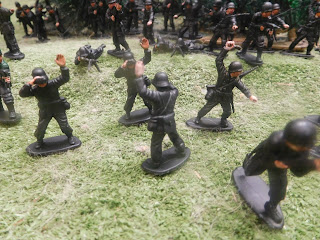New Blog Header
I finally worked out how to replace the picture of the nice pussy cat with the picture of the nice Confederate partisan raiders. That is a damned good painting! I just recently found it in the ether.
For those who have been reading my blog for a while you would know that ACW topics played a prominent part in my history of ACW wargaming. A customized unit of Quantrill's Raiders were among my favorites in my ACW armies. As a good contrarian I often championed the cause of William Quantrill's 'redemption'. The war in Kansas and Missouri was a nasty one alright but Quantrill and the James boys, among others, whilst being 'bad asses', were not worse than their Union Red Leg counterparts and were frequently motivated by revenge for the raids of the former into Missouri.
Some incorrect things said about Quantrill is that he killed women and children. He actually had a code which forbade that and told his men he would shoot any who harmed a woman. He also was not an 'outlaw' but an irregular guerilla fighter. Nor were the James boys 'outlaws' until they refused to lay down their arms after the war and turned to robbing banks.
Another claim is that Quantrill was not recognized by the Confederacy. Quantrill did receive a colonel's commission from General Price. However it is true that the Confederate government disowned Quantrill after his deadly raid on Lawrence Kansas.
Quantrill's men were excellent horsemen and excellent shots with their multiple pistols that festooned their persons and their horses. They had a number of military successes although it is true that their enemies were often militia. They serve as an elite unit in my army and have special rules for concealment and sneaky tactics like wearing enemy uniforms (although they may also have done this partially from need as clothes wore out).
My toy version of Quantrill's Raiders gained fame in their part in a very early ACOTS convention at Adelaide when they participated in a very early morning successful cavalry charge on a tennis court.
DISCALIMER: For those squeamish about such things admiring the Confederate defense of hearth and home, including by partisans like Quantrill is not the same as a defense of slavery. However, I do think that the arguments of mostly Southern historians have merit and I outline some of them in my added comment.










But still an "irregular guerilla fighter" in the cause of treason in defense of human slavery - a cause that was "one of the worst for which a people ever fought, and one for which there was the least excuse.”
ReplyDeleteI probably opened a can of worms with that one. I usually steer clear here of things with political overtones. Quantrill's men were defending hearth and home and did so very effectively. They were effective, fierce fighters and for those things I admire them.
ReplyDeleteHowever, just for sake of argument I'll take the two main contentions. First off, and this is a technical issue and you can find plenty of material on both sides of the argument, those who seceded were not 'traitors'. Implicit in the Constitution was the voluntary nature of the Union, which was originally called a confederacy. States entered it voluntarily and if it did not serve their interests could withdraw. This was especially important to Texas which, for a time had been an independent country. After the ACW the interpretation and constitutional law was altered to prevent this possibility. Whether the constitutional grounds were sound or not the war was a 'War Between the States'.
The second issue of slavery was indeed inseparable from the war. It was because of it that Britain and France refrained from assisting the South. It also triggered the war. However Lincoln did not say he would get rid of slavery until the 1863 Gettysburg Address, half way through the war. He also applied this only to those in 'rebellion against the US'. The war was fought by the North to 'preserve the Union', not to free slaves, although this was the ultimate by-product. The war was largely caused by the North's opposition to new states allowing slavery and the South's refusal to agree. There were other issues about tariffs and so on. Many thousands of Americans fought and died in a war which had the end of slavery as its ultimate result. However the moral issue of good guys and bad guys is not so clear cut.
On the other hand there were prominent Southern leaders who were opposed to slavery, or at least lukewarm but still fought for the South. Lee was one and even Jefferson Davis contemplated ending slavery, if only to obtain foreign support. The vast majority of Southern soldiers were not slave owners. Some Union army leaders were slave owners. Grant had a very small number which he inherited by marriage. Admittedly he was not happy about such an inheritance and eventually freed them.
Chances are slavery would have come to an end in the South without the war although at a later date.
The other consideration is that thousands of Southern Negroes (as well as Hispanics) fought for the South, especially in the first years of the war.. These were both free Negroes and slaves. The numbers of Negroes who eventually fought for the Union were much greater however the ones who fought for the South also have memorial statues.
One of the most amazing stories of the war was the case of the free Negro who was Quantrill's cook. His wife had been a slave until she was killed by Federal jayhawkers. He had been trying to raise the money to free her and it shows that slavery was more complicated than is often thought. But, more to the point, rather than targeting the slave owners he wanted revenge on the Federals. One day he walked into Quantrill's camp and offered his services. The Raiders were suspicious but he gained their trust and he became not only a cook but an armed spy.
I say all that to suggest that even supposedly 'black and white' issues are often much greyer than would at first appear.
Southern farms in Missouri were being burnt down and the loot taken back to Lawrence and other pro Union towns. A teenage Jesse James watched his step father lynched by pro Union raiders in an attempt to get him to divulge the whereabouts of his older brother, Frank, who was then serving in the regular Confederate army. The step dad survived but James became a guerilla fighter at sixteen. At the close of the war he tried to surrender but was shot. He escaped and recovered to become, along with Frank one of America's most well known outlaws.
A couple of films that capture the nature of the war in Missouri and Kansas are Ride with the Devil and The Outlaw Jesse James.
The C.S.A. was a nation built on a slim foundation of democratic consent: Of its total population of 9 million, only about 1.5 million were white men of voting and military age; the rest—white women and the enslaved—formed the vast ranks of the politically dispossessed. Political consent, and popular support for the war effort, were accordingly shallow.
DeleteThe C.S.A. was a fraction of the size of its enemy. The Union had 10 times its manufacturing capacity, and its population of 22 million dwarfed that of the Confederacy. It quickly became clear what such imbalances meant: The Confederacy had to exert unsupportable demands on its population, and to build up a powerful central-state government to do what the private sector could not.
After one year of war, the Davis administration was forced to adopt the FIRST conscription act in American history. Because enslaved men were not available for military service, it was forced to mobilize a far higher proportion of white men. By the end of the war, a staggering 75 to 85 percent of white men ages 15 to 55 had served. Combined with the exemptions the government was forced to make for slaveholders, conscription quickly gave rise to charges that it was a “rich man’s war, poor man’s fight.”
The C.S.A.’s level of military mobilization was unsupportable in an agrarian society. By 1863, the government faced a starvation crisis and a wave of food riots organized by white soldiers’ wives protesting the government’s military policies.
I have read that article too. Although certainly interesting there are a few things that add some perspective. As for women voting that was highly restricted all around the world and certainly in the USA, not just the CSA. Women didn't officially get the vote until the 20th century. As for restrictions on race they certainly also applied in the USA and throughout the 19th and much of the 20th century. I'm including Northern states here. Throughout much of history democracies have been 'Athenian'. Voting has been restricted on grounds of property, gender, race or nationality. We still don't allow non citizens to vote or else why have a nation? And we restrict people on the basis of age or if they are serving jail time. I'd be interested to see the figures for who could vote in the Union. (Incidentally, the CSA pioneered postal voting for soldiers).
DeleteSome other things that give pause for thought are that there were many thousands more free blacks in the Confederacy than the Union. Why didn't they head North? There were draft riots in the US during this war and blacks were lynched IN THE NORTH.
Of course the South faced a formidable adversary which is probably one reason it got a lot of sympathy in Europe. Even so it could have won if the early successes had been immediately followed up. After First Bull Run the road to Washington was open. Also Lee could have won Gettysburg if his forces had reached there first, if his cavalry had made themselves available etc.
Almost forgot - the CSA offered eventual statehood for the Indian territory as an Indian state. (Native Americans played a substantial role in the CSA army of the West.
DeleteThis comment has been removed by the author.
ReplyDeleteLee, in the same tract, also described slavery as an 'evil'. Lee was a creature of his time and his attitude was not that much different from Lincoln except in degree.
DeleteFor example, initially Lincoln was not prepared to propose the abolition of slavery especially as he did not want the Union to fracture. He also shared a popular idea of sending the black population back to Africa. This is how the colony of Liberia was later begun. Lee also stated that if abolition of slavery would preserve the Union he was for it. The problem was the abolitionists represented an extreme political movement (almost like ISIS today) as they were often prepared to use any means to achieve this and John Brown and his followers are examples.
Lee's wife had freed her slaves and Lee intended to do so over a five year period. He also left substantial inheritance to one of his slaves.